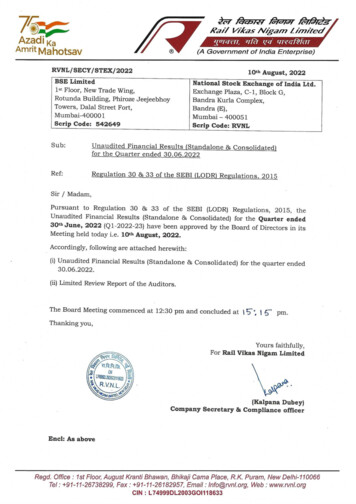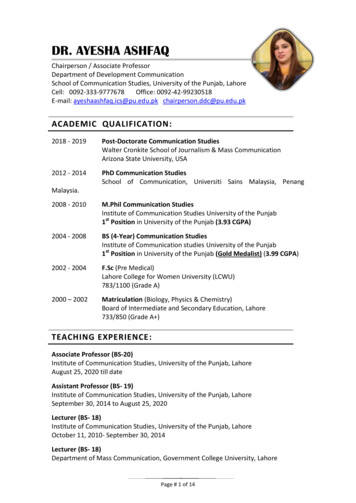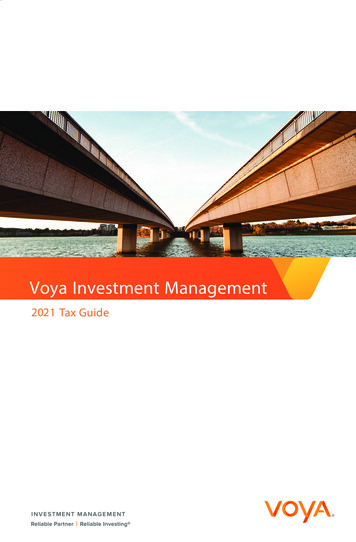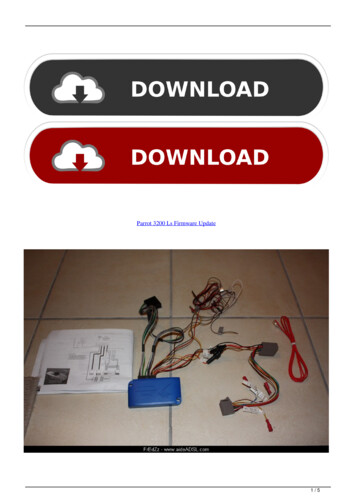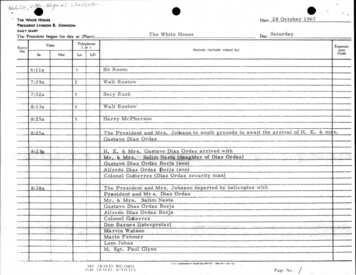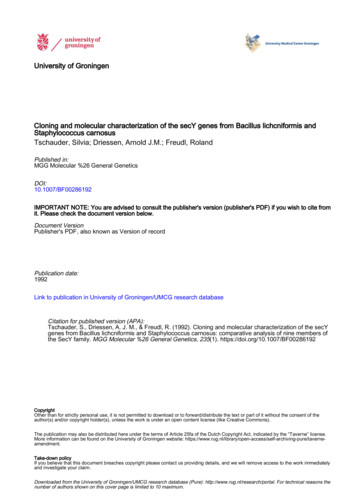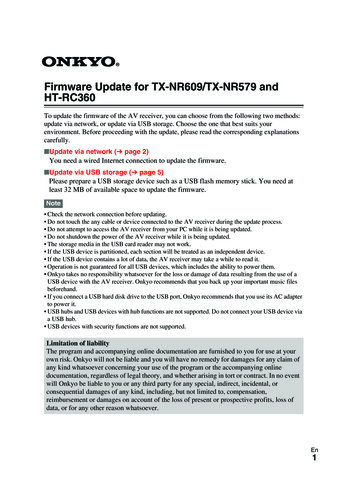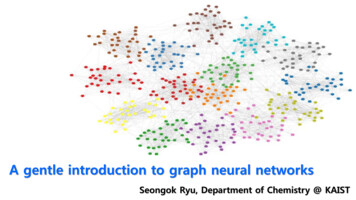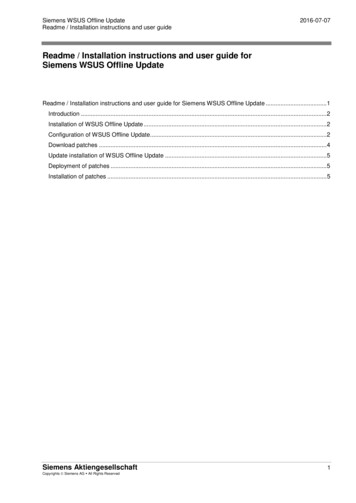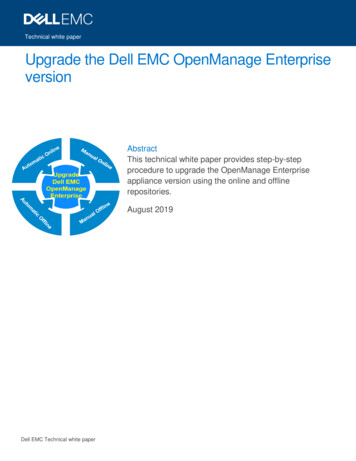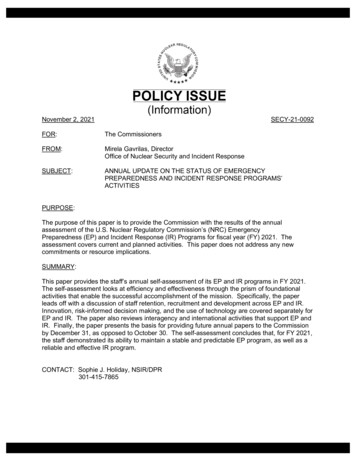
Transcription
November 2, 2021SECY-21-0092FOR:The CommissionersFROM:Mirela Gavrilas, DirectorOffice of Nuclear Security and Incident ResponseSUBJECT:ANNUAL UPDATE ON THE STATUS OF EMERGENCYPREPAREDNESS AND INCIDENT RESPONSE PROGRAMS’ACTIVITIESPURPOSE:The purpose of this paper is to provide the Commission with the results of the annualassessment of the U.S. Nuclear Regulatory Commission’s (NRC) EmergencyPreparedness (EP) and Incident Response (IR) Programs for fiscal year (FY) 2021. Theassessment covers current and planned activities. This paper does not address any newcommitments or resource implications.SUMMARY:This paper provides the staff’s annual self-assessment of its EP and IR programs in FY 2021.The self-assessment looks at efficiency and effectiveness through the prism of foundationalactivities that enable the successful accomplishment of the mission. Specifically, the paperleads off with a discussion of staff retention, recruitment and development across EP and IR.Innovation, risk-informed decision making, and the use of technology are covered separately forEP and IR. The paper also reviews interagency and international activities that support EP andIR. Finally, the paper presents the basis for providing future annual papers to the Commissionby December 31, as opposed to October 30. The self-assessment concludes that, for FY 2021,the staff demonstrated its ability to maintain a stable and predictable EP program, as well as areliable and effective IR program.CONTACT: Sophie J. Holiday, NSIR/DPR301-415-7865
The Commissioners2DISCUSSION:The NRC staff assesses the agency’s EP and IR programs on an annual basis to ensurealignment with NRC’s strategic security and safety goals. The NRC staff provided the lastannual update in October 2020. 1Self-AssessmentNRC’s EP and IR programs continue to align with the agency’s strategic security and safetygoals 2 identified in the FY 2018-2022 Strategic Plan. The staff assessed the FY 2021 EP andIR programs’ performance against the FY 2021 priorities as outlined in the October 2020 paper.Staff retention, recruitment and developmentThe staff utilized several processes to maintain an engaged and highly skilled EP and IRworkforce now and for the future. The NRC’s Strategic Workforce Planning process identifiedthat the agency will soon experience numerous EP and IR staffing losses due to attrition. EPand IR need the skills and knowledge to ensure continued: (1) timely completion of EP-relatedlicensing activities for operating, new, and advanced reactors, including decommissioningrelated reviews; (2) maintenance of NRC headquarters (HQ) and regional IR capabilities,including facilities, systems, procedures, and processes; and (3) support for EP policy oversightand development. To address staffing gaps, concerted efforts were made in the following: Ensuring current EP and IR staff and potential internal and external candidatesunderstand the viable pathways for future career growth through the EP and IRprograms;Putting in place effective knowledge management programs and developing Nuclepedia 3pages.Hosting summer hires and co-ops and utilizing the Nuclear Regulatory ApprenticeshipNetwork;Facilitating succession planning by increasing the use of rotational opportunities and jobshadowing as tools to enhance knowledge transfer and to build bench strength;Creating diverse teams and providing leadership opportunities to junior staff;Focusing on enhancing culture by implementing changes following staff feedback andFederal Employee Viewpoint Survey results; andEmbracing the NRC’s Evidence-Building and Evaluation Policy Statement to makeinformed evidence-based decisions and communicating the bases to internal andexternal stakeholders.SECY-20-0101 (ADAMS Accession No. ML20280A780), “Annual Update on the Status of EmergencyPreparedness and Incident Response Programs’ Activities.”2 These goals include maintaining readiness to respond to accidents, integrating safety and securityconsiderations in EP licensing activities, and maintaining and further risk-informing a stable andpredictable EP regulatory infrastructure.3 Nuclepedia is the NRC’s knowledge resource wiki, a continuously evolving online encyclopedia ofnuclear regulatory information including articles, documents, graphics, animations, and presentations.1
The Commissioners3Emergency Preparedness ProgramInnovationThe EP program staff came up with numerous recommendations for how to improve NRC’sexisting operations, processes, and programs. The EP program staff used crowdsourcingcampaigns and facilitated open discussions on how to improve the agency’s processes andday-to-day business. As an example, the EP program adapted its licensing and oversightapproach to respond to the Coronavirus Disease 2019 (COVID-19) pandemic. Specifically, inFY 2021, the staff granted 17 exemptions from onsite EP exercise requirements. Similarly, thestaff granted 21 exemptions from offsite EP exercise requirements to mitigate the impacts of theCOVID-19 pandemic. In November 2020, staff issued temporary staff guidance (TSG), 4 whichprovided guidance for the conduct of EP-related inspection activities throughout a variety ofdisruptive situations, including a pandemic, while maintaining employee health and safety andmaintaining the stated objectives of the EP cornerstone in the reactor oversight process and thecornerstone performance expectation as stated in Inspection Procedure 71114, “ReactorSafety-Emergency Preparedness.”Risk-informed decision makingStaff risk-informed licensing reviews, inspection/oversight activities, rulemaking, and guidancedevelopment. Notable activities in FY 2021 included: Issuance of Revision 1 to NUREG/CR-7002, “Criteria for Development of EvacuationTime Estimate Studies,” 5 on February 9, 2021, which addressed the size of theevacuation models, the impact of a shadow evacuation, modeling adverse weather, theuse of manual traffic control, and various other parameters of importance. The formatand criteria provided in the guidance will support consistent application of the evacuationtime estimate (ETE) methodology and will facilitate consistent NRC review of ETEstudies.Issuance of two licensing amendments on September 21, 2021, 6 andSeptember 27, 2021, 7 respectively, to revise the emergency plans for the SouthernNuclear Corporation fleet, which adjusts the emergency response organization staffingcomposition as well as the response time.Continued development of: (1) the Emergency Preparedness Requirements for SmallModular Reactor and Other New Technologies Rulemaking (final rule due to theCommission December 2021); (2) Alignment of Licensing Processes and LessonsLearned from New Reactor Licensing Rulemaking (proposed rule due to theTSG-NSIR-2020-02 (ADAMS Accession No. ML20288A523), “Additional Guidance for EP InspectionsDuring the Public Health Emergency.”5 The guidance reflects the importance of various evacuation time estimate (ETE) model parametersbased on the results of an applied research study on ETEs published in NUREG/CR-7269,“Enhancements to Evacuation Time Estimate Guidance.”6 License Amendment for six units: Joseph M. Farley Nuclear Plant, Units 1 and 2; Edwin I. HatchNuclear Plant, Unit 1 and 2; and Vogtle Electric Generating Plant, Units 1 and 2 (ADAMS Accession No.ML21217A091).7 License Amendment for Vogtle Electric Generating Plant, Units 3 and 4 (ADAMS Accession No.ML21217A021).4
The Commissioners4Commission May 2022); and (3) the Risk-Informed, Technology Inclusive RegulatoryFramework for Advanced Reactors Rulemaking (proposed rule due to the CommissionMay 2022). 8The use of technologyThe EP program staff continue to use data analytics to highlight areas for regulatory attentionand improvement. While working remotely during the COVID-19 pandemic, the EP staff usedvarious electronic communication applications, such as Microsoft (MS) Teams and WebEx, toeffectively and efficiently conduct government-to-government meetings and public meetings withinternational, industry, and public stakeholders. The staff, in collaboration with the Office ofNuclear Reactor Regulation’s Mission Analytics Portal Team, are developing dashboards for EPlicensing actions and full-time equivalent utilization. Both dashboards, expected to becompleted in FY 2022, will enable staff to monitor performance, manage workload, identifypotential areas of risk, and learn from historical experience. Lastly, the NRC and the FederalEmergency Management Agency (FEMA) began utilizing the FEMA Preparedness Toolkit webinterface to jointly review licensee requests related to EP exercises. This toolkit was expandedto include interagency reviews for revisions to licensee Alert and Notification System DesignReports as sites implemented the Integrated Public Alert and Warning System.Incident Response ProgramInnovationIn November 2020, the NRC completed its transition to the enhanced IR program, which: alignsthe NRC’s response structure with those of other Federal response organizations; allows aflexible, scalable response structure; incorporates regional and HQ responders; and (4)expands the program from a small response to a full agency response. While finalizing thetransition, the IR program remained agile and functional while performing IR exercises in avirtual environment due to the COVID-19 pandemic. In February 2021, as a follow-up to the2004 Office of the Inspector General (OIG) audit of the IR Program, 9 the staff completed aself-assessment (Enclosure) of the newly updated IR program and determined that the changesaligned with OIG’s recommendations. The self-assessment also concluded that the NRC’s IRprogram continues to be effective.In FY 2021, the NRC conducted 13 exercises with NRC power reactor licensees. Historically,HQ staff only participated in one exercise per region. In FY 2021, HQ staff participated in all buttwo of the regional exercises, resulting in a 200-percent increase in exercise participation.Following each exercise, the staff conducted after-action report (AAR) meetings to assess andidentify areas for improvement or clarity. As an example, two new products were developed,the response status report (RSR) and the event status board (ESB). The RSR and ESB areused as the basis for briefings of events within the NRC and with external stakeholders. As theIR program matures, the staff will continue to refine it to respond to all potential hazards.Risk-informed decision makingIn response to the COVID pandemic, the staff used tools and flexibilities from the agency’spandemic plan and made changes to mitigative action based on Federal guidance. Moreover,89The staff has requested a 9-month extension, which is pending Commission approval.OIG-04-A-0020, “Audit of NRC’s Incident Response Program.” ADAMS Accession No. ML042790283.
The Commissioners5the IR program staff used initial lessons learned from the COVID-19 pandemic response toinform its 2021 updates to the NRC’s continuity of operations program and pandemic plans andprocedures.The use of technologyThe staff coordinated actions across the agency to review, evaluate, and plan for updates to thecurrent IR needs and requirements such as space, technologies, and processes. The planaddressed mission and business drivers for the NRC’s Headquarters Operations Center and theregional incident response centers. Focus areas included: assessment and planning tooptimize the remote functionality; integrate technology to identify resource and productivityefficiencies; and optimization of space planning. Some of the more innovative ideas includedmulti-purpose space use and leveraging technology to bring in specialized responders. Thestaff recognized that a hybrid (in-person and virtual) response can be effective and efficient.The staff used four exercises to validate the new IR program. Because of the NRC facilityoccupancy restrictions resulting from the COVID-19 pandemic, the staff responded to three ofthese exercises virtually. A hybrid response, with minimal in-person staff, was applied for thefourth exercise. The staff used the AARs from these exercises to identify strengths and areasfor improvement. The staff also evaluated multiple virtual meeting platforms10 and concludedthat MS Teams provides the best flexibility and functionality for virtual and hybrid response.Following the transition period, the staff conducted an additional hybrid response exercise toevaluate the minimum in-person position requirements. The staff has not conducted a full inperson response exercise. Therefore, the staff will continue its evaluation to determine ifadditional changes are warranted to the IR program following the conduct of FY 2022 in-personexercises. In August 2021, 11 the staff successfully employed a hybrid approach in real-timeduring its Hurricane Ida response.The staff also developed an IR dashboard to determine if there were any weaknesses orchallenges that could potentially impact the agency’s readiness to respond to a nuclear orterrorist emergency situation or other events of national interest.Lastly, the staff completed a project to modernize the HQ operational officer (HOO) databaseused to store, retrieve, and develop reports for various emergency and non-emergencynotification requirements. The new database, which is interfaced to a web-based client,increases the ability of the HOOs to enter and retrieve data more efficiently and streamline thedevelopment of reports. The staff has also begun exploring the use of technology to automatereports made to the HOOs by licensees. This is expected to be completed in FY 2022.Interagency and International PartnershipsThe staff continued its engagement with its interagency and international partners to accomplishthe NRC’s EP and IR goals. In FY 2021, the staff increased its communication efforts with Stateand local organizations, FEMA, the Federal Radiation Protection Coordinating Committee, theU.S. Navy, and the U.S. Environmental Protection Agency (EPA). In addition to regularlyscheduled meetings, the staff ought opportunities for information sharing, collaboration and toclarify positions and authorities.1011Virtual meeting platforms included Skype, WebEx, and MS Teams.Notice of Unusual Event declared at Waterford Nuclear Generating Station.
The Commissioners6The staff participated in internationally sponsored Webinars, training, and meetings to stayinformed. The staff made presentations and initiated outreach on topics ranging from toadvanced reactors to plume exposure pathway and emergency planning zone size. Staffengaged with the Japanese-led Emergency Management Working Group and the InternationalAtomic Energy Agency (IAEA)’s Emergency Preparedness and Response StandardsCommittee to exchange lessons learned from to the COVID-19 pandemic. The staff ensuredthat positions taken in IAEA international safety standards and guides remain consistent withNRC’s EP and IR programs.In FY 2021, the staff conducted four exercises with the IAEA’s Incident and Emergency Centerand several interagency partners: two of the exercises simulated emergencies at U.S. nuclearpower plants and two simulated emergencies in other countries. In addition, staff participated intwo other international exercises, where another IAEA Member State simulated a reactoraccident. In those exercises, the IAEA coordinated the sharing of technical information andrequests for assistance and the NRC worked with its Federal response organization partners12.All exercises validated the NRC’s procedures for conducting and providing accident analysis tothe IAEA and strengthened the staff’s understanding of sharing information.In moving forward with policy development for advanced reactors, by way of the “Risk-Informed,Technology Inclusive Regulatory Framework for Advanced Reactors” rulemaking, the staffengaged the United Kingdom and Canada to share knowledge and experience. The staff alsodiscussed non-radiological health impacts due to a radiological emergency with the NuclearEnergy Agency.Path ForwardAgency activities, including EP and IR, are planned and implemented on a FY cycle. The staffwants to synchronize the periodicity of the annual update on the status of EP and IR programswith the FY cycle of these activities. Moreover, the end of the FY coincides with administrativeactivities which compete with generating the annual update. Therefore, the staff intends tosubmit future annual papers by December 31st as opposed to October 30th.CONCLUSION:The NRC’s EP and IR programs satisfied priorities in FY 2021 that directly supported the NRC’smission and strategic plan. The staff continues to demonstrate their ability to maintain a stableand predictable EP program, as well as a reliable and effective IR program. Furthermore, thestaff continues to maintain and enhance the NRC’s readiness to respond to events atlicensee facilities and to support international emergencies. The NRC is capable of fulfilling itsresponsibilities in the national response structure.Federal response organization partners include Department of State, Department of Energy, and theEPA.12
The Commissioners7COORDINATION:The Office of the General Counsel reviewed this package and has no legal objection.Mirela GavrilasDigitally signed by MirelaGavrilasDate: 2021.11.02 15:37:02-04'00'Mirela Gavrilas, DirectorOffice of Nuclear Securityand Incident ResponseEnclosure: As stated
The CommissionersSUBJECT:8ANNUAL UPDATE ON THE STATUS OF EMERGENCY PREPAREDNESS ANDINCIDENT RESPONSE PROGRAMS’ ACTIVITIES DATED NOVEMBER 2, 2021NSIR-08-0015ADAMS Accession Numbers: ML21274A015 (Pkg), ML21274A049 (Paper), ML21274A016(Encl)OFFICENSIR/DPRNSIR/DPROGCTech lasDATE10/5/2110/6/2110/14/2110/20/21OFFICIAL RECORD COPY11/02/21
optimize the remote functionality ; integrate technology to identify resource and productivity efficiencies; and optimization of space planning. Some of the more innovative ideas included multi-purpose space use and leveraging technology to bring in specialized responders. The
